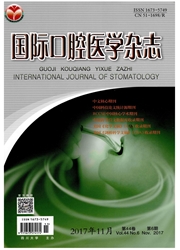

 中文摘要:
中文摘要:
二膦酸盐药物是治疗骨质疏松的药物,而骨质疏松与牙体脱落在老年人群中普遍存在,故骨质疏松与牙体脱落的种植牙治疗可能同期进行,但是同时进行这两种治疗的患者却出现了大量的二膦酸盐药物相关性颌骨坏死(BRONJ)。研究显示,二膦酸盐诱导BRONJ的风险可能与用药方法、药物效力、治疗时间及其他局部或系统性因素有关。本文就二膦酸盐影响骨内种植体的危险因素、二膦酸盐的药理作用及导致种植体失败的原因、控制BRONJ的方法等研究进展作一综述。
 英文摘要:
英文摘要:
Both osteoporosis and tooth loss are prevalent in the elderly population. Thus, implant use is essential in solving the problem of missing teeth in osteoporotic patients undergoing bisphosphonate treatment. Incidents of osteonecrosis of the jaw, known as bisphosphonate-related osteonecrosis of the jaw(BRONJ), have been reported in persons using bisphosphonates and undergoing invasive dental implants. Many studies show that the risk for bisphosphonateinduced osteonecrosis may be influenced by the route of drug administration, the potency and duration of use, as well as other local and systematic factors. This study reviews the risk factors of bisphosphonates that affect bone implants, the pharmacological effects of bisphosphonates, how bisphosphonates lead to implant failure, and how to control BRONJ.
 同期刊论文项目
同期刊论文项目
 同项目期刊论文
同项目期刊论文
 Effects of Er-Zhi-Wan on microarchitecture and regulation of Wnt/β-catenin signaling pathway in alve
Effects of Er-Zhi-Wan on microarchitecture and regulation of Wnt/β-catenin signaling pathway in alve Effect of decreased implant healing time on bone (re)modeling adjacent to plateaued implants under f
Effect of decreased implant healing time on bone (re)modeling adjacent to plateaued implants under f Effect of retinoic acid on the function of lipopolysaccharide-stimulated bone marrow stromal cells g
Effect of retinoic acid on the function of lipopolysaccharide-stimulated bone marrow stromal cells g 期刊信息
期刊信息
